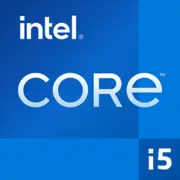Intel Core i5-13500

Intel Core i5-13500: Comprehensive Review of the Processor for 2025
March 2025
1. Key Characteristics: Architecture and Performance
Raptor Lake: Evolution of Hybrid Architecture
The Intel Core i5-13500 belongs to the Raptor Lake generation, which is a logical continuation of the hybrid architecture introduced in Alder Lake. The chip combines 6 Performance cores (P-cores) with Hyper-Threading support (12 threads) and 8 Efficient cores (E-cores) (8 threads), resulting in a total of 14 cores and 20 threads. This configuration is optimized for multitasking: P-cores handle "heavy" tasks (gaming, rendering), while E-cores manage background processes.
The Intel 7 process (10 nm Enhanced SuperFin) provides a balance between energy efficiency and performance. Compared to Alder Lake, Raptor Lake features an increased L3 cache (24 MB) and improved load distribution algorithms among the cores.
Performance in Numbers
- Geekbench 6: 2405 (Single-Core), 12304 (Multi-Core).
- For comparison, the i5-12500 (Alder Lake) scored around 2100/10500.
- Cinebench R23: ~1800 (Single), ~16500 (Multi).
- Gaming: When paired with an RTX 4060 at Full HD — 90-120 FPS in AAA titles (Cyberpunk 2077, Horizon Forbidden West).
Key Features:
- Support for PCIe 5.0 (16 lanes for GPU + 4 for NVMe).
- Integrated graphics UHD 770 (base gaming performance: 30-40 FPS in CS2 at low settings).
- Intel Deep Learning Boost and Gaussian & Neural Accelerator technologies for AI tasks.
2. Compatible Motherboards
LGA 1700 Socket: Chipset Selection
The processor uses the LGA 1700 socket, compatible with chipsets B760, H770, Z790 (for Raptor Lake) and B660, H670, Z690 (after BIOS update).
Recommendations:
- B760 (price: $120–$180): Optimal for most users. Examples:
- ASUS TUF Gaming B760-Plus — a reliable board with PCIe 5.0 and 2.5 Gb LAN.
- MSI Pro B760M-A WiFi — a compact option with Wi-Fi 6.
- Z790 ($200–$300): For enthusiasts needing overclocking (if using a CPU version with "K" in the index).
Important: When selecting boards with 600-series chipsets (such as Z690), check Raptor Lake support via BIOS update.
3. Supported Memory: DDR4 vs DDR5
The processor works with DDR4-3200 and DDR5-5600. By 2025, DDR5 has become more accessible, but the price difference remains:
- DDR4-32 GB (3200 MHz): ~$70.
- DDR5-32 GB (5600 MHz): ~$110.
Tips:
- For gaming and everyday tasks, DDR4 is sufficient.
- DDR5 is justified in workloads (video editing, 3D modeling).
- Be sure to enable XMP profile in BIOS for maximum speed.
4. Power Supply: Power Calculation
With a TDP of 65 W, the processor does not demand much from the PSU, but it's important to consider other components:
- Without discrete GPU: A PSU of 400–500 W is sufficient (for example, be quiet! Pure Power 11 500W).
- With GPU like RTX 4070: A recommendation of 650–750 W (example: Corsair RM650x).
Rule: Add 150–200 W to the TDP of all components. For i5-13500 + RTX 4060: 65 W + 115 W = 180 W → 550 W PSU.
5. Pros and Cons
Pros:
- Excellent price-to-performance ratio ($230–$250).
- Low power consumption (65 W).
- Integrated graphics for office PCs or backup usage.
Cons:
- No overclocking capability (no "K" multiplier).
- Falls short against Ryzen 7 7700X in demanding workloads.
6. Use Case Scenarios
Gaming
The processor will not become a bottleneck when paired with a GPU like the RTX 4060 or RX 7700 XT. In CPU-intensive games (for example, Microsoft Flight Simulator), the frequency of the P-cores (up to 4.8 GHz) ensures smooth FPS.
Work Tasks
- Video Editing: Rendering a 4K project in Premiere Pro will take 15% less time compared to the i5-12500.
- Programming: Fast code compilation due to multithreading.
Multimedia
Streaming in OBS (1080p60) is possible without lag even when using integrated graphics.
7. Comparison with Competitors
AMD Ryzen 5 7600X ($270):
- Pros: Higher IPC, PCIe 5.0 support on all lanes.
- Cons: More expensive, requires DDR5.
Intel Core i5-13400F ($200):
- Lacks integrated graphics, but is 10-15% cheaper. Suitable for gamers with a discrete GPU.
Conclusion: The i5-13500 outperforms its competitors in multithreaded tasks and energy efficiency.
8. Practical Assembly Tips
1. Cooling: The boxed cooler will suffice, but for quieter operation, choose a tower cooler (for example, DeepCool AK400).
2. Case: Ensure adequate ventilation. At least two fans (for intake and exhaust) are recommended.
3. BIOS Update: For motherboards on 600-series chipsets, use the Flashback feature (if available).
9. Final Conclusion: Who is the i5-13500 Suitable For?
This processor is ideal for:
- Gamers building a PC for $800–1000.
- Office users who need reliability and quiet operation.
- Content creators with moderate requirements (editing 1080p/1440p).
Why choose it? The balance of price, performance, and energy efficiency makes the i5-13500 one of the best mid-range CPUs in 2025. If you don't need the maximum FPS in 4K or 8K video rendering — this is your choice.
Prices are valid as of March 2025.
Basic
CPU Specifications
Memory Specifications
GPU Specifications
Miscellaneous
Benchmarks
Compared to Other CPU
Share in social media
Or Link To Us
<a href="https://cputronic.com/cpu/intel-core-i5-13500" target="_blank">Intel Core i5-13500</a>